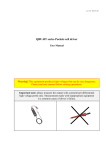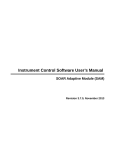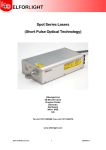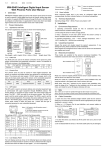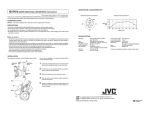Download PDF user manual..
Transcript
rev 1.05 / 2015 01 05 QBU-10kV Pockels cell driver User manual Warning! This equipment produces high voltages that can be very dangerous. Please read user manual before starting operations. Important note: please measure the output with symmetrical (differential) high voltage probe only. Measurement made with inappropriate equipment is a common cause of driver’s failure. Overview QBU-10kV Pockels cell driver produces high voltage pulses with high repetition rate, fast risetime and falltime, adjustable voltage amplitude and pulse width. Two control types are available: manual and automatic Interfaces / signals / descriptions INTERFACE (Molex 39-30-1060): INTERFACE 8 7 6 5 4 3 2 1 PIN (color) DESIGNATION DESCRIPTION While “0” or ”1” is applied to PIN1 high voltage output is maintained correspondingly at 0V or HV level 1 (transparent) Pulse 2 (violet) Temperature Monitor 3 (red) +15 V Provides +15V DC output level; maximal current capability is 100mA 4 (blue) Enable HV output is enabled / disabled by PIN4 (“1” – enable, “0” – disable) 5, 6 (black) Interface Return 7 (yellow) HV Monitor Sequences of incoming pulses with period less than approx. 200 ns will be ignored by the driver Provides internal temperature state (see also temperature monitor section) PIN5 and PIN6 are connected to the driver’s ground circuit The voltage at PIN7 is a monitor signal proportional to the measured value of the high voltage output 10kV corresponds to 10V at PIN7, 4kV corresponds to approx. 4V at PIN7 8 (green) HV Program Positive DC voltage applied to PIN8 sets up high voltage value HV 10kV corresponds to 10V at PIN8, 4kV corresponds to approx. 4V at PIN8 “0” means logical 0 low level (0V), “1” means logical 1 high level (5V) +24V (Molex 39-30-1040): +24V 4 3 2 1 PIN (color) DESIGNATION DESCRIPTION 1, 2 (red) +24V DC INPUT positive 24V DC for turn on the Pockels cell driver 3, 4 (black) RETURN Return from power supply producing +24V DC HV OUTPUT (Molex 39-30-1060): PIN (color) DESIGNATION DESCRIPTION 1 (blue) Negative HV Negative 4 (red) Positive HV Positive 2, 3, 5-8 N/C - “ENABLE” JUMPER: One can use “ENABLE” JUMPER instead of “ENABLE” signal of INTERFACE. It isn’t recommended to use “ENABLE” JUMPER and “ENABLE” signal at the same time. “HV PROGRAM” JUMPER AND “HV PROGRAM” TRIMPOD: One can use “HV PROGRAM” JUMPER instead of “HV PROGRAM” signal of INTERFACE. If this jumper is set on, the output voltage is defined with “HV PROGRAM” TRIMPOD state. It isn’t recommended to use “HV PROGRAM” JUMPER and “HV PROGRAM” signal at the same time. Safety Warning! This equipment produces high voltages that can be very dangerous. Don’t be careless around this equipment Avoid casual contacts of personnel with output cables and with the load Do not connect / disconnect cables while driver is turned on Do not operate with disconnected load Be very careful setting jumpers on and off and using HV Program trimpot; accidental contact to the board may be fatal; from the same point of view it’s recommended to control the driver not manually, but remotely via Interface connector • Be careful with driver’s neighborhood; do not store disordered items close to any side of the driver • Do not turn the driver on if it was already damaged with water, chemicals, mechanical or electrical shock; do not self-repair the driver • • • • Operations (Manual control) 1. 2. 3. 4. 5. 6. Connect +24VDC power supply, pulse generator and Pockels cell Set up “HV PROGRAM” JUMPER Turn on +24VDC power supply Set up “ENABLE” JUMPER Use “HV PROGRAM” TRIMPOD to set up required output voltage Send driving pulses from pulse generator to PIN1 of INTERFACE. Set pulse width longer than 200 ns 7. To power down the driver, turn off +24VDC power supply or remove “ENABLE” JUMPER Operations (Automatic control) 1. 2. 3. 4. 5. Connect +24V, INTERFACE and HV OUTPUT connectors to the board Remove “HV PROGRAM” JUMPER, remove “ENABLE” JUMPER DISABLE the high voltage output Apply the correct nominal DC INPUT power to the module Set up the required output voltage by applying a DC voltage to the HV PROGRAM PIN8 of INTERFACE 6. ENABLE the high voltage output 7. Send driving pulses to PIN1 of INTERFACE. Set pulse width longer than 200 ns 8. To power down the driver, remove DC INPUT power or DISABLE high voltage output Technical notes • Performance of the module greatly depends on load capacitance. Full performance is achievable at load capacitance < 11 pF. Higher load capacitance decreases maximal allowed repetition rate • Module’s output is bipolar. This means that e.g. 4kV pulse is physically formed by applying +2kV to the positive output wire and – 2kV to the negative (see figure) +2kV 0V -2kV Nevertheless, all descriptions of HV output are given in terms of voltage differences. Please keep it in mind! • Sometimes output is delayed. If no switching of the output voltage occurs for a long time (about 100 us) the driver needs to refresh its state. During refreshment it’s prohibited to switch the output. As a result if pulse width is more than 100 us or if the distance between two sequential pulses is more than 100 us, sometimes switching of the high voltage output may be delayed. The delay time is about 150 ns. Specifications ELECTRICAL SPECIFICATION 1 2 Input Output Working mode HV higher level 1 HV lower level 1 Pulse width Max. repetition rate Risetime / falltime Jitter Delay time Protections Environment Operation temperature Storage temperature Humidity +24V DC; 0.5 A max repetition of the input TTL signal adjustable in 4 – 10 kV range 0 V, fixed 200 ns – DC > 1 kHz at the full load (10 kV, 11 pF) < 20 ns / <25 ns 2 ~ 1,5 ns ~ 150 ns from overheating (approx. 72 °C) 0...+40 °C -20...+60 °C 90%, non-condensing In terms of bipolar output (see also Technical notes section) 10-90% level, warranted at load capacitance 11 pF and below MECHANICAL SPECIFICATION Size (LxWxH) 132 x 105 x 50 mm Weight < 0,2 kg












